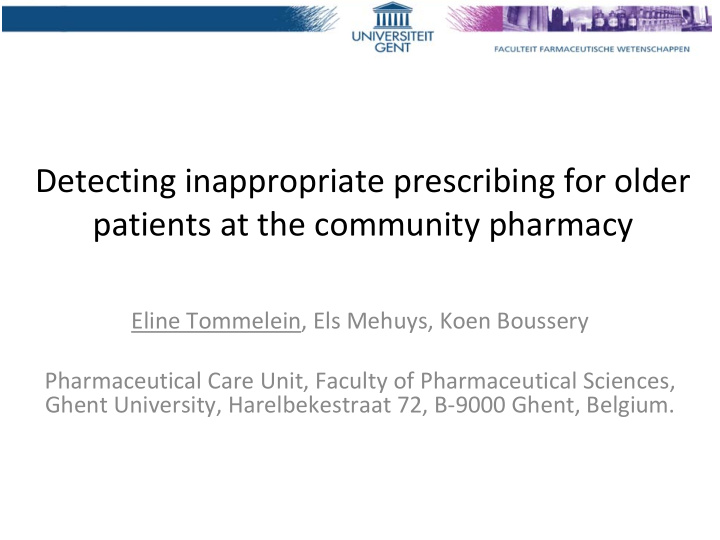



Detecting inappropriate prescribing for older patients at the community pharmacy Eline Tommelein, Els Mehuys, Koen Boussery Pharmaceutical Care Unit, Faculty of Pharmaceutical Sciences, Ghent University, Harelbekestraat 72, B ‐ 9000 Ghent, Belgium.
Introduction • Role community pharmacist: – from dispenser → care ‐ giver • Support prescribers by executing final check for IP upon dispensing medication need for feasible screening tool
Introduction • Existing tools: – Implicit vs explicit – Time ‐ consuming / Too extensive – Specifically designed for hospital settings – Require unavailable clinical information – Lack scientific evidence – Not offer alternative treatments – Validation?
Objective To develop, validate and implement a screening tool ‐ to detect inappropriate prescribing ‐ in older patients ( ≥ 65 year) ‐ at the community pharmacy
Project overview • Part 1: select those criteria with most clinical relevance to primary care • Part 2: Re ‐ evaluating retained criteria, second selection based on current applicability in Belgian community pharmacy practice • Part 3: Validation + testing feasibility and acceptance • Part 4: Finetuning & interventional research
Part 1 Selecting those criteria with most clinical relevance to primary care
Part 1: Methods • Multidisciplinary Delphi panel (RAND/UCLA ‐ method) (February – April 2013) – Literature review – Starting from all items mentioned on any IP ‐ list – First exclusion (e.g. drugs not on Belgian market) – First Delphi round: Written questionnaires – Second Delphi round: face ‐ to ‐ face meeting • Geriatric specialists, general practitioners, clinical pharmacologists, community pharmacists, clinical pharmacists
Part 1: Results – List 1 : Potentially inappropriate medication for older patients, independent of diagnosis • Part 1: Drug classes: 11 items • Part 2: Specific molecules: 21 items – List 2 : Potentially inappropriate medication for older patients, dependent of diagnosis • Part 1: Drug classes: 12 items • Part 2: Specific molecules: 12 items
Part 1: Results – List 3 : Potential prescribing omissions for older patients • 7 items – List 4 : Drug ‐ Drug interactions of specific relevance in older patients • 28 items – List 5 : General care ‐ related items for older patients to be addressed in the pharmacy • 6 items
Part 1: Example
Part 2 Second selection based on current applicability in Belgian community pharmacy practice
Part 2: Methods • Pharmacists Delphi round (June ‐ July 2013) – Literature review – Starting from explicit list from part 1 – First Delphi round: written questionnaires – Second Delphi round: Face ‐ to ‐ face meeting • Community pharmacists
Part 2: Results – List 1 : Potentially inappropriate medication for older patients, independent of diagnosis • Part 1: Drug classes: 11 items 11 items • Part 2: Specific molecules: 21 items 20 items – List 2 : Potentially inappropriate medication for older patients, dependent of diagnosis • Part 1: Drug classes: 12 items 9 items • Part 2: Specific molecules: 12 items 2 items
Part 2: Results – List 3 : Potential prescribing omissions for older patients • 7 items 6 items – List 4 : Drug ‐ Drug interactions of specific relevance in older patients • 28 items 29 items – List 5 : General care ‐ related items for older patients to be addressed in the pharmacy • 6 items 6 items
Part 2 ‐ example
Part 3 Observational trial: Identification & prevalence of IP, validation, testing feasibility & acceptance
Part 3: Methods • Observational study (dec 2013 – july 2014, 190 community pharmacies, ± 900 ptn) • Objectives – Identification of inappropriate prescribing and prevalence in Belgium according to new screening tool – Validation • Compare with other existing lists (Choice: PRISCUS, START/STOPP, Beers, Laroche) – Testing feasibility and acceptance • Pharmacists • Doctors (GP, specialists) • Patients
Part 4 Interventional trial
Part 4: Methods • Finetuning of the screening tool based on Part 3 • Interventional trial (end 2014) – Locally organized • Objective – Screening has impact on prescribing? – Improving prescribing has influence on patient outcomes? • Health related quality of life • Hospitalizations
Part 5 Implementation?
Thank you for the attention Any questions?
Recommend
More recommend